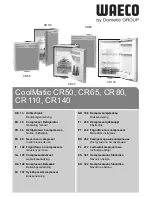
4.2 Defrosting
4.3 Out of operation
0$,17(1$1&($1'&$5(2)7+($33/,$1&(
4.1 Overall cleaning
Please unplug the refrigerator for defrost and cleaning.
Dust behind the refrigerator and on the ground should be cleaned to improve the cooling effect and
energy saving.
Check the door gasket regularly to make sure there is no debris. Clean the door gasket with a soft
cloth dampened with soapy water or diluted detergent.
The interior of the refrigerator should be cleaned regularly to avoid odors.
Turn off the power before cleaning the interior, remove all foods, drinks, shelves, drawers, etc.
Use a soft cloth or sponge to clean the inside of the refrigerator with two tablespoons of baking soda
and a quart of warm water. Then rinse with clean water and wipe clean. After cleaning, leave the door
open and let it dry naturally before turning the power back on.
For areas that are difficult to clean in the refrigerator (such as narrow areas, gaps or corners), it is
recommended to wipe them regularly with a soft cloth or brush, to ensure no contaminants or bacteria
accumulation in these areas.
Do not use soap, detergent, scrub powder, spray cleaner, etc., as these may cause odors in the
interior of the refrigerator or contaminated food.
Clean the bottle frame, shelves and drawers with a soft cloth dampened with soapy water or diluted
detergent. Dry with a soft cloth or dry naturally.
Wipe the outer surface of the refrigerator with a soft cloth dampened
with soapy water, detergent, etc., and then wipe dry.
Do not use hard brushes, steel wool balls, wire brushes,
abrasives (such as toothpaste), organic solvents (such as alcohol,
acetone, banana oil, etc.), boiling water, acid or alkaline items, which
may damage the fridge surface and interior. Boiling water and organic
solvents such as benzene may deform or damage plastic parts.
Do not rinse directly with water or other liquids during cleaning to
avoid short circuits or affect electrical insulation after immersion.
The refrigerator is equipped with an automatic defrosting function. Frost formed due to change of
season or temperature may also be manually removed by shutting off the refrigerator and disconnecting
it from power supply or by wiping with a dry towel.
Power failure: In case of power failure, even if it is in the summer, foods inside the appliance can be
kept cold for several hours. During the power failure, the times of door opening should be reduced, and
no more fresh food should be put into the appliance.
Long-time nonuse: The appliance should be unplugged and then cleaned. The doors should be left
open to prevent odor.
Moving: Before the refrigerator is moved, take out all objects that are inside, secure the glass partitions,
vegetable holder, freezing chamber drawers etc. with tape, and tighten the leveling feet; close the doors
and seal them with tape. During moving, the appliance should not be laid upside down or horizontally or
be vibrated; the tilt during movement shall be no more than 45°.
d
e
r
et
g
t
n
e
The appliance should run continuously once it is started. Generally, the operation of the
appliance should not be interrupted; otherwise the service life may be impaired.
15




































